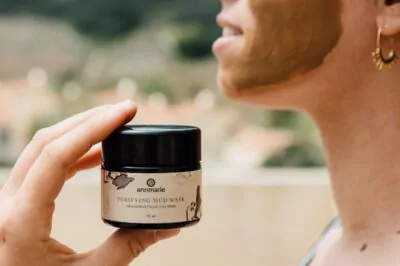Guest Post from Sarah Anma with Vegetarian Health Institute
Eating Clean and still not as healthy as you want to be?
As a nearly life-long vegan, I thought I was doing all the right things. I have been eating very clean for decades and yet I had troubling health problems including hypothyroidism and infertility. I wondered… “How can this be?” I sought help from all sorts of experts ranging from nutritionists and naturopaths to traditional Chinese medicine practitioners, until finally I was driven to allopathic medicine.
Nothing worked or gave me the results I yearned for.
Then my husband told me about some very simple things that I could do without altering my diet, and I knew I'd found an answer to all of my searching. Now I am experiencing the best health of my life.
We want to live in a world where nutritious, sustainable plant-based foods are accessible to all. So we created VegHealth Institute, where we focus on teaching people how to make conscious choices about their food and get the nutrition their bodies need.
Today we’re sharing a lesson about Vitamin D from our Mastery Program with the Annmarie Skin Care Family and as an extra bonus, the Vegetarian Nutrition Guide along with an e-booklet dedicated to teaching you to Supercharge Your Health with Whole Foods.
Check it out!
Does Wearing Sunscreen Cause Vitamin D Deficiency?
Hidden Gluten in Your Supplements? How to Choose a Good One
10 Ways that Spending Time Outdoors Actually Makes You Healthier
Vegetarian Health Institute Mastery Program Lesson 11: Vitamin D
What Is Vitamin D?
Vitamin D is an amazing molecule. Though classically associated with calcium absorption and bone health, it is now recognized that vitamin D is involved in many functions in the body.
It is made from a molecule of cholesterol, so its structure is similar to cortisol, testosterone and other molecules in the steroid family.
What Does It Do?
There are vitamin D receptors in most organs, including the heart, bones, skin, genitals, prostate, breast, white blood cells and brain. Consequently, vitamin D has profound effects on many bodily functions. These range from bone health to fighting infections, avoiding artery disease, and preventing cancer.
Vitamin D is very involved in positive calcium balance and good bone health. To be specific, Vitamin D:
- Increases absorption of calcium from food into your bloodstream.
- Reduces calcium loss in your urine.
- Inhibits the breakdown of bone (by inhibiting osteoclast cells in your skeleton)
Where Does It Come From?
In humans and other animals, sunlight irradiates a form of cholesterol in the skin, creating cholecalciferol, known as vitamin D3. This molecule passes through the liver and through the kidneys, undergoing chemical changes along the way and finally turning it into the active form of vitamin D.
If you’re at latitude south of Atlanta, Georgia in the summertime, and you’re outdoors when the sun is bright and high in the sky, 20 minutes of sunlight on your face, arms, hands or back twice weekly can theoretically create adequate amounts of vitamin D. Trade-off Alert: Spending more than 20 minutes out in the sun without sunscreen increases aging and cracking of the skin.
However, many factors can foil this mechanism, including cloud cover, smog, increasing age of skin, sunscreen (which effectively stops vitamin D production), and skin color. (Darker pigmentation of skin lengthens the time needed for vitamin D production.)
Our ancient ancestors, who spent their lives in the African sunshine with little or no clothing, had no problem making enough vitamin D. Of course, their skin also undoubtedly showed the weathering and leathering that such a lifestyle produces but they likely did not care about the cosmetic appearance of their sun-blasted skin, and probably died long before skin cancer or melanoma would have developed.
People who live in sunny climates today have to face the same trade-off, and most actively avoid overexposure to the sun. That’s why even people in Florida and similar climates are often deficient in vitamin D. People living in northern latitudes have less to fear from sun exposure, but they also make a lot less vitamin D in their skin.
Since most people today spend their days inside buildings and clothed so vitamin D levels are low in most populations. To be safe, we recommend supplemental vitamin D for anyone who doesn’t live in the tropics and spend most of their day out in the sunshine.
How Much Vitamin D Do You Need?
Not long ago, we believed most people could get adequate vitamin D from sunlight. On this basis, the USDA recommended the following daily intake for both men and women:
- Birth to 50 years: 5mcg (200 IU)
- 51-70 years 10 mcg (400 IU)
- 71+ years 15 mcg (600 IU)
In recent years, however, we’ve realized the limited power of the sun to produce adequate vitamin D levels. We’ve also developed a greater appreciation for vitamin D’s many important roles.
While the “official” dosage recommendations have yet to be revised upward by the U.S. government, here’s what many nutritionally-aware clinicians are now recommending now:
- For infants and children: 400 IU daily
- For men and women: 1000 – 2000 IU daily
Before you start supplementing, have the 25(OH) vitamin D level in your blood measured and chat with your clinician about adding an oral Vitamin D supplement.
Plant and Animal Sources Of Vitamin D
Alas, no whole plant foods contain significant amounts of usable vitamin D in their natural form. However, when portabella mushrooms and white “button” mushrooms are briefly exposed to intense ultraviolet light, their naturally-occurring ergosterol is activated to vitamin D2 (ergocalciferol) in quite significant amounts.
According to one study, each gram of UV-exposed mushroom contained approximately 3.8 mcg of vitamin D2. At 40 International Units per microgram, that’s 152 IU. So a 100 gram serving of UV-exposed mushrooms (approximately 3 ounces) would provide 1520 IU of vitamin D2, a very generous amount for anyone’s daily diet. Indeed there is a report of a man curing his vitamin D deficiency utilizing irradiated mushrooms only!
Some websites claim that kelp, horsetail, nettles, parsley, sweet potatoes, and alfalfa contain vitamin D but the USDA Nutrient Data Base puts the amount of vitamin D for these foods at zero.
Plant-based Vitamin D2 is found in vegan vitamin supplements and most fortified non-dairy milks. We used to recommend Dr. Fuhrman’s Gentle Care Formula because it used to contain exclusively D2, but now it also has D3.
Some researchers say vitamin D2 is as effective in humans as vitamin D3. Others say vitamin D3 is more effective but vitamin D3 comes from sheep wool lanolin or the skin of cows and pigs.
Back in the early 80’s, some dairies were using cod liver oil as a vitamin D source. Now, since there is so much cow and pig skin coming out of slaughterhouses, most prefer extracting cholecalciferol (D3) from animal skins. And here’s the clincher…
There’s no law requiring food manufacturers to indicate the sources of the D3 added to their foods. There couldn’t be. That’s because after D3 is extracted, purified, and crystallized, it’s impossible to determine the original source.
Vitamin D is a fat-soluble substance, and as such, has a half-life in the body of 2-3 weeks. In other words, half of all vitamin D molecules disappear from the system in 20-29 days.
Vitamin D Deficiency
The most common cause of deficiency is inadequate intake and lack of sun exposure. Much less common is the inability to absorb the vitamin, and diseases of the liver and kidney that prevent activation of vitamin D.
Deficiency can lead to crumbly bones (rickets in children, osteoporosis in adults) as well as increased susceptibility to:
- Peripheral artery disease
- Memory loss and “brain fog”
- Depression
- Autoimmune diseases, including type I diabetes
- Parkinson’s disease
- Influenza
- Tuberculosis
- Multiple sclerosis
- High blood pressure
- Coronary artery disease and Peripheral artery disease
- Cancer of colon, breast, ovaries ,pancreas and prostate
- And aging, by not preventing shortening of chromosome telomeres
Problems With Excess Vitamin D
More is not better! Consuming more than 40,000 IU daily can lead to excessive calcium levels in the blood, high blood pressure nausea and vomiting, increased thirst, and eventually kidney failure.
Upshot: No one should take more than 10,000 IU daily, and the 1000 IU to 2000 IU range should be sufficient for most children and adults.
Cautions: People with tuberculosis, lymphoma, sarcoidosis, and primary hyperparathyroidism who take too much supplemental vitamin D risk excessively high levels of calcium. They need the guidance of an experienced health professional.
Measuring Vitamin D Levels: People should have their levels of 25-hydroxy-vitamin D levels measured every year to two, along with vitamin B-12 and MMA levels. The optimal blood level is 35-50 ng/ml (or, for our Canadian friends, 90-140 nmol/l).
If levels are below 35 ng/ml, supplementation with 1000 IU to 2000 IU daily is advised, followed by a blood level check in 6 to 12 months to see if the dosage is adequate.
Want More Digestible Health Information?
VegHealth Institute is sharing these amazing e-books just for our community. Check them out for more amazing nutritional information that could totally change the way you look at your diet.
Supercharge Your Health with Whole Foods
What “health foods” aren't optimal for your health? In eye-opening booklet: “12 Ways to Supercharge Your Health With Whole Foods”. It shows you why so-called “health foods” are aging you, and which foods are the real nutrient powerhouses.
Sign up for FREE Just click here
Vegetarian Nutrition Guide
How do Vegetarians Get Calcium, Iron, Protein, A, B12 & D?? Find out with our Vegetarian Nutrition Guide. When you request it, you'll also receive some of the same health secrets our students pay top dollar for. Sign up for FREE to receive your vegetarian nutrition guide.
Click here to Download Your Guide Now







